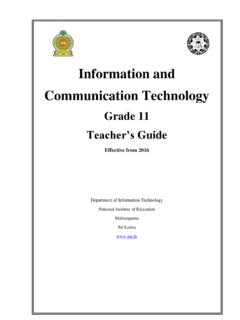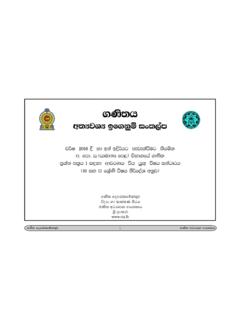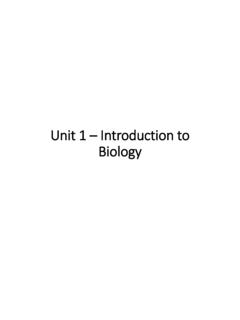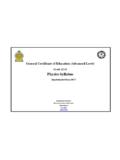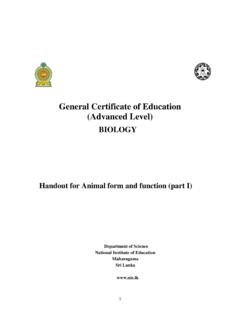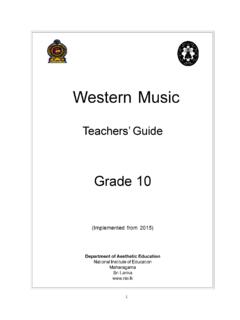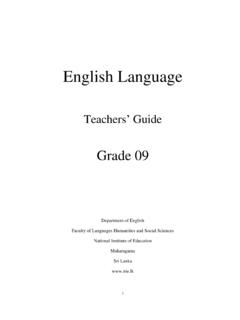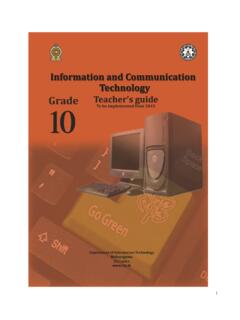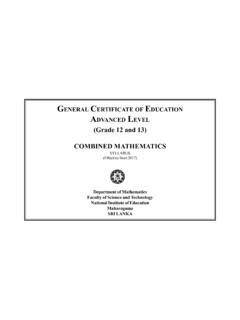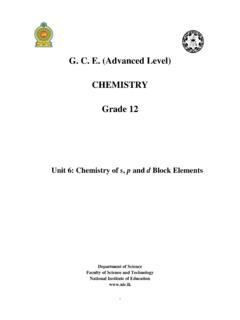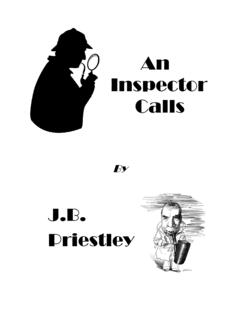Transcription of PHYSICS Practical Handbook - nie.lk
1 G. C. E. (Advanced Level)PHYSICSP ractical HandbookDepartment of ScienceFaculty of Science and TechnologyNational Institute of Education(effective from year 2017) C. E. (Advanced Level)PhysicsPractical Handbook National Institute of EducationISBN: -Department of ScienceNational Institute of EducationWebsite : from the Director GeneralWith the intention of realising the National Educational Objectives recommended by the National Education Commission and with the primary intention of developing common competencies, the content based curriculum which was earlier effective was modernised and the fi rst phase of the new competency based curriculum of an eight year cycle was introduced by the National Institute of Education to the primary and the secondary education system of Sri Lanka in on the facts revealed by research and the suggestions by various sectors on education.
2 A curriculum rationalization process has resulted in the second phase of the curriculum cycle which has commenced its introduction from primary intention of the new rationalized curriculum is to admit the student community into a more student centered and activity based education pattern while transforming to a human resource armed with skills and competencies required for the world of this rationalization process, to orderly build up all subject competencies from base level to the higher level the vertical integration method has been employed, while to minimise as much as possible the repetition of the same subject matter over and over again and to limit the subject content and develop a student friendly curriculum which can be implemented, the horizontal integration method has been teaching - learning process of science, Practical work is an important component.
3 The engagement in Practical work at a high level enables the students to develop their talents, to understand the scientifi c investigation process and enhance their conceptual Practical Handbook is prepared with the intention of guiding both the teacher - student sectors to successfully perform activities of planning Practical experiments, effi cient engagement of students in the learning process and uplifting their Practical talents in the fi eld of take this opportunity to convey my gratitude to the members of the Council and of the Academic Affairs Board of the NIE and the resource persons who contributed to the preparation of this Practical Handbook for their dedication to achieve success in this (Mrs) T. A. R. J. GunasekaraDirector GeneralNational Institute of EducationMaharagamaivMessage from the Director (Science)This Practical Handbook has been compiled to assist the student in reaching expertise in the subject area of science.
4 We have been in commutation with university lecturers, teachers and curriculum experts during the designing of this book. The experiments in this Handbook are introduced with the intention of achieving the objectives of the PHYSICS curriculum. Stated below are three reasons which may be interrelated regarding the importance of performing Practical experiments in school, but can be mentioned as separate ones. 1. Assistance to build up scientifi c concepts (knowledge and comprehension) and integration of theoretical matters with Practical matters 2. Developing investigational talents 3. Building up Practical talents and to excel in itDuring performing and experimenting we believe that the teacher being concerned of the above mentioned reasons would assist the student to have a better understanding of the subject, to uplift in him/ her the talents possessed by a scientist, to have manipulative skills required for further education and job oppertunities connected with STEM subjects (Science, Technology, Engineering and Mathematics).
5 In order to make Practical work effective, the laboratory should be made a place of learning by doing. Also, the teacher should provide guidance to maintain the following norms inside the laboratory. Keeping the place of work clean High concern by students about their activities Keeping the tables of the laboratory free of stoppers of chemical bottles Minimising wastage of water, gas and electricity Reading carefully and following the guidance provided for the respective experiment Teachers should allow the student s entry in lab in his/ her presence Performing only those experiments allocated by the teacherI take this opportunity to express my gratitude to all university lecturers, teachers and other resource persons who contributed in their endeavour to the successful production of the Practical Handbook .
6 Also fi nally I wish that this attempt will be helpful to strengthen our young generation as members of societies rich in information and technologically A. D. Asoka de SilvaDirectorDepartment of ScienceNational Institute of EducationvResource Contribution (2018 revised copy)Guidance Dr. (Mrs) T. A. R J. Gunasekara, Director General, National Institute of EducationSupervision Dr. A. D. Asoka de Silva, Director, Department of Science, National Institute of EducationSubject leadership P. Malavipathirana, Senior Lecturer, Department of Science, National Institute of EducationEditing P. Malavipathirana, Senior Lecturer, National Institute of Education Dr. M. L. S.
7 Piyatissa, Assistant Lecturer, Department of Science, National Institute of Education Miss R. A. Amarasinghe, Assistant Lecturer, Department of Science, National Institute of EducationEnglish translation D. S. Withanachchi, Former Chief Project Offi cer (Education Technology), National Institute of EducationEnglish language Dr. (Mrs.) Chandra Amarasekaraediting Consultant, National Institute of EducationTypesetting and Jayaruwan Vijayawardhana,page designing freelance Computer Graphic DesignerLaboratory assistance M. Welipitiya, Laboratory Assistant, Department of Science, National Institute of EducationOther assistance (Mrs) W.
8 P. P. Weerawardhana, Department of Science, National Institute of Education K. R. Dayawansa, Department of Science, National Institute of EducationviResource Contribution (2015 First Copy)Instructions Prof. W. M. Abeyrathna Bandara Director General, National Institute of EducationGuidance and direction M. F. S. P. Jayawardena, Deputy Director General, Faculty of Science and Technology, National Institute of EducationSubject coordination M. L. S. Piyatissa, Assistant Lecturer, Department of Science, National Institute of EducationEditing P.
9 Malavipathirana, Senior Lecturer, Department of Science, National Institute of Education M. L. S. Piyatissa, Assistant Lecturer, Department of Science, National Institute of Education Mrs. M. R. P. I. J. Herath, Assistant Lecturer, Department of Science, National Institute of Education W. D. I. Upamal, Assistant Lecturer, Department of Science, National Institute of Education Miss R. A. Amarasinghe, Assistant Lecturer, Department of Science, National Institute of EducationPanel of writers P. Malavipathirana, Senior Lecturer, Department of Science, National Institute of Education W.
10 A. D. Rathnasuriya, Former Chief Project Offi cer ( PHYSICS ), National Institute of Education B. A. Tilakaratne, Former Project Offi cer ( PHYSICS ), National Institute of Education D. S. Vithanachchi, Former Chief Project Offi cer (Education Technology), National Institute of Education H.
